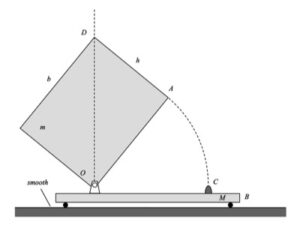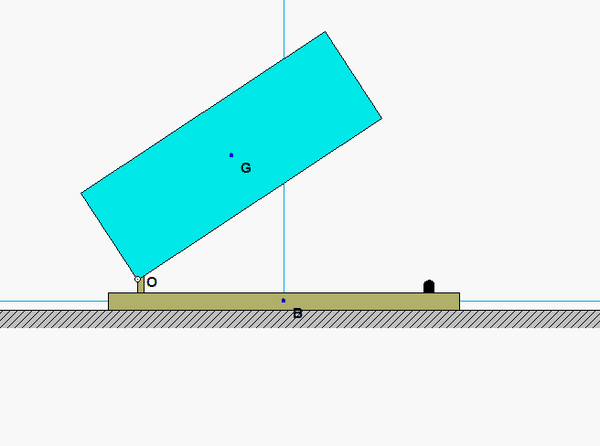| Problem statement Solution video |
DISCUSSION THREAD

Any questions?? Please ask/answer questions regarding this homework problem through the "Leave a Comment" link above.
Discussion and hints

The four-step plan:
- FBD: It is recommended that you draw a free body diagram of the plate and cart combined.
- Kinetics: Your FBD should show that the summation of forces in the direction of motion for the cart (call that the x-direction) is zero; therefore, linear momentum in the x-direction is conserved for ALL time. Also note that energy is conserved up to the point of impact. During impact, energy is not conserved; however, you are given the coefficient of restitution (COR) for the impact.
- Kinematics: Write down the rigid body velocity equation relating the motion of points O and the plate's center of mass G. Here you will use the fact that the cart moves only in the x-direction.
- Solve
When trying to solve for the velocity of G just before impact I have the equation from conservation of linear momentum and a kinetics equation of G in x and y directions (3 equations) but I have 4 unknowns: vgx, vgy, vbx, and wg. Am I missing an equation for the velocity just before impact?
In the hints above, it discusses the fact that energy is conserved up to the point before impact (if you use a large FBD). Because of this, it is easy to use work energy to solve for vg2 and then use the kinematics equations to break up vg2 into its components.
Another note is that I technically solved for part b first. Keep in mind that the COR is 0. What does that mean for the speeds of g and o for state 3 (the state immediately after impact)? This leaves you with a relationship between vg2 and vo2 in your linear momentum equation.
It is okay to assume that this system has gravity acting on it right?
Yes you can assume the system has gravity acting on it. What I did to help me is I drew the system as if it already hit the ground so it is easier to look at and I treat the two blocks separately so instead of one mg force I had two separate ones.
Can we assume that the cart that the block is on is a particle or do we have to consider it a rigid body because in example 5.C.9 we considered the block that was sliding to be a particle rather then a rigid body.
It's important to remember that the velocity of the cart is the same as the velocity of the plate after the impact because e=0.
It is important to note that this only applies to the normal direction for the impact, which in this case is the y-direction. This can be seen by the coefficient of restitution equation.
For this problem, when using energy, to find T2, or kinetic energy of system just before it hits bumper, can we use either of the two methods --> T2 = 1/2*I_o*w_o^2 + 1/2*m*v_o^2 + 1/2*M*v_B^2 or T2 = 1/2*I_G*w_G^2 + 1/2*m*v_G^2 + 1/2*M*v_B^2? Would they get you the same answer? From what I understand, I don't think it makes a difference because by considering the rotational and translational kinetic energy about O, the decrease in translational kinetic energy compared to point A (since Va > Vo=Vb) is accounted for by the increase in rotational kinetic energy about point O (since parallel axis theorem increases moment of inertia). Would this be a correct analysis?
TITUS: Of the two expressions for T that you list above, you are able to use only the second (using G as the reference point for the plate).
You canNOT use the first expression since it uses O as the reference point. Recall that for the "short form" of T, the reference point must be either the CM or a fixed point. O is neither the CM nor a fixed point.
This is a very important issue in using the W/E equation for rigid bodies. Let us know if you have questions on this. Please read section 5B in the lecture book.
Im confused, can you use the coefficient of restitution to say that the velocities of the block and bar are the same after collision since the line of impact is horizontal? Wouldn't that mean that the velocities in the y direction are the same but not necessarily the x direction?
The COR equation relates only the y-components of velocity of points A and C; the equation, by itself, says nothing about the x-components of velocity for those two points, or for any other points.
Note that the x-components of velocity for the plate CM and of the cart are related by the linear momentum equation in the x-direction.
Im confused, can you use the coefficient of restitution to say that the velocities of the block and bar are the same after collision since the line of impact is horizontal? Wouldn't that mean that the velocities in the y direction are the same but not necessarily the x direction?
Would it be advantageous to use two separate FBDs and use the energy equations based off just the block? or should I use an FBD of the full system and assume conserved momentum?
What is the benefit to drawing your FBD with the cart and plate inside of it compared to drawing seperate FBDs for them individually?
Note that energy and linear momentum in the x-direction are NOT conserved for the plate and the cart INDIVIDUALLY.
However, if you draw the FBD of the plate and cart TOGETHER, energy and linear momentum in the x-direction are conserved prior to the impact. Doing so saves you a considerable amount of effort in solving the problem.
I'm confused on the kinematics. In example 5.c.9 that is similar the bar is parallel and thus in the kinematics equation the vector from the pivot point to the center of mass is just in the i direction but in this problem, we have an i and j component and it doesn't seem to allow you to make the assumption one of them is zero at impact like we did in 5.c.9. Are we supposed to assume one of them is zero and if so how do we get to this assumption?
I'm confused as to how we are supposed to find the initial potential energy of the plate. Do we have to make our own theta? I assume we can't treat the whole plate as a particle like in lecture example 5.C.9. Also, at state 2, would there still be a potential energy of the plate if it can no longer "fall" any lower, even though it's still technically above the datum?
You shouldn't need to use any angles in your calculations. When the block is "displaced slightly to the right of a vertical line," it is basically in line with the vertical line and can be treated as such. The potential energy depends on where you set your datum. If you set the datum on the cart, which is what I recommend, the plate will have potential energy at in both the initial state and the state before impact. This is calculated using the height of the center of mass. If you set the datum at the final height of the plate's center of mass, it would not have potential energy at the end, but this may complicate your initial potential energy calculation.
A good way to go about solving this is using work energy and conservation of momentum, which 5.C.9 shows well. The substitution may be a bit tricky, so I would leave everything as variables.
In the rigid body equation relating O and G, is it okay to assume that V_O is 0?
You can assume that V_O is 0 in the y-direction but the x-direction cannot be assumed to be 0. The simulation above shows this well.
Since linear impulse momentum is conserved at all times in the x-direction for the system including the plate and the cart, does that mean I can use LIM from state 1 to 3 to find the velocity at state 3 of the plate?
Try using conservation principles (momentum and energy) to analyze initial conditions and determine velocities before and after impact, utilizing the coefficient of restitution e for after impact.
To try and solve this question I first drew out my free body diagram and then used Linear Momentum and the work energy equations. After that I used kinematics, and finally related all of these together to find the initial and final velocity before and after impact.
Although linear momentum is conserved in the x direction, this does not neccesarily mean that v = 0 in the x direction
Hey guys! I put the datum through the sheet/block M the main giant block is resting on and it really helped me solve the equations for the problem.